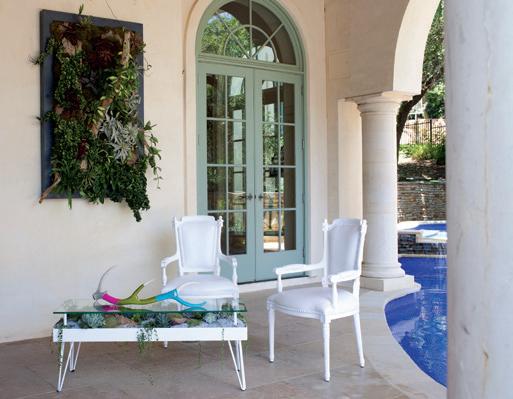
4 minute read
Vertically Verdant
By Claudia Alarcón
These days, most people are familiar with living walls, also known as vertical gardens. In Central Texas, some of the country’s most coveted designers are taking this botanical art form to the next level.
Advertisement
In Johnson City, Variance Design is the creation of Zac Zamora, a native Texan with a Zoology degree from The University of Texas at Austin. For the past 15 years, he has spearheaded the design and fabrication of permanent exhibits for zoos, museums and science centers across the country, highlighting his ever-evolving experimentation with living systems and how they can incorporate more biophilia in our everyday lives. The company specializes in design, construction and installation of
VARIANCE DESIGN
terrariums, vivariums and living walls, ranging from 3’ x 3’ residential applications to habitats for public zoos, aquariums and corporate settings measuring over 1,000 square feet.
While the latter require advance support systems and extensive care by dedicated staff, their residential works are designed with basic maintenance in mind. Cavan Carruth, a Variance Design project manager, says that all depends on the complexity of the living system. “For our 3’ x 3’ living walls, it is as simple as attaching a cleat to a wall for mounting, access to a standard wall outlet for power and quality water supplied from anywhere, preferably reverse osmosis, to manually refill the basins,” he says.
These small wall units are fabricated from quality materials and come in attractive frames to fit various architectural styles. They don’t require special installation such as plumb
ing and can be added to almost any surface. Each system includes a recirculating micro-pump and grow LEDs, but they are quiet and reliable.
“Our 3’ x 3’, self-contained units need water refills, typically about as often as you would water a potted house plant, depending on the humidity, evaporation and placement,” says Carruth. “Our indoor walls grow under full-spectrum LED lighting controlled by timers and dimmers. Our more complex systems are watered and fertilized automatically and can be controlled remotely through our monitoring system.”
Using artificial light means they can be placed anywhere, opening more options for including biophilia throughout your indoor environment. “We have done large outdoor walls that do not need artificial light, but climate and placement are critical for success,” says Carruth.
Most plants used in living walls are epiphytic species that do not need soil to grow, known colloquially as air plants. Variance generally uses different aroids, ferns and occasionally certain orchids. The plants are usually healthier and easier to maintain because the habitat is closer to how they live in nature. Like
VARIANCE DESIGN
most house plants, they may need monthly maintenance for trimming and replacing nutrient supplies when needed.
“Our more advanced living systems are usually maintained by professional servicing companies, and our monitoring system allows us to constantly know the health of the living walls and we can communicate with the service provider if there is a concern,” says Carruth.
In Austin, Monique Capanelli has been making custom living walls for commercial and residential applications since founding her company, Articulture Designs, in 2009. Some of her large-scale work can be seen at Shuck Shack and Whole Foods Market, among others. Her designs range from powdercoated steel structures to classic vintage frames filled with low-maintenance plants — succulents, bromeliads, tillandsias — and enhanced by driftwood, seashells, seed pods and other organic elements to create fantastic landscapes.
When designing custom residential pieces, Capanelli encourages her clients to think about maintenance needs and placement. “We work together with designers and architects to locate the best placement for a living wall based on three initial criteria: natural lighting conditions, the logistics of maintenance on the wall after installation, and the way people move in the space,” she says.
Living walls for interior spaces need an ample amount of bright indirect or even direct natural sunlight, and walls that face south or southwest yield the best results. There are many plants that can do well vertically, especially the bromeliad family which includes air plants and cryptanthus, as well as orchids, pothos, grasses, and even succulents.
Maintenance and watering are determined by each client’s needs and the types of plants used. “Most of my residential walls are best watered manually,” says Capanelli. An outdoor covered patio is an ideal location for plants that need more regular watering, such as ferns. For walls that include moss or tillandsia, the occasional misting with a sprayer is enough.
A few years back, Capanelli expanded her portfolio by

launching a line of Living Furniture™. She designs every piece,
ARTICULTURE DESIGNS

from coffee tables to patio furniture to working desks. Custom built by professionals, these pieces come in wood, steel and acrylic, and incorporate low maintenance plants. Care for these stunning pieces is the same as that for a plant potted in a container with no drainage. Capanelli recommends a light watering schedule to prevent waterlogging. “People tend to over water,” she says. “When it comes to these pieces, less is definitely more.”
Thanks to their ease of care and maintenance, and their calming, purifying and aesthetically pleasing qualities, these showstoppers are suitable for any home or office environment. u
VARIANCE DESIGN
info@variancedesign.com | www.variancedesign.com
ARTICULTURE DESIGNS
512-762-5228 | www.articulturedesigns.com










